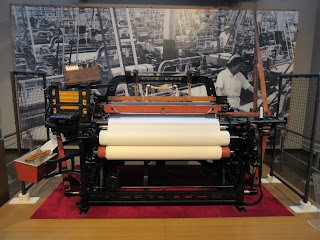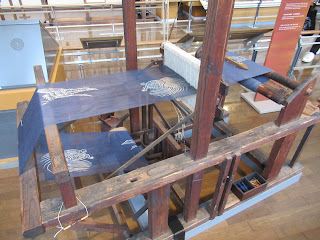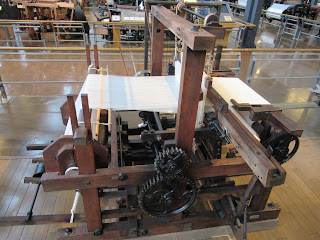After lunch, I took a train on Meitetsu Line to Sako, the next station from Nagoya. From the Sako Station, it was only a few minutes walk to the final destination of the day, Toyota Commemorative Museum of Industry and Technology. Toyota is one of the most famous automobile companies in the world. The founder of Toyota Group is Sakichi Toyoda (1867-1930) who invented the first power loom in Japan and established spinning and weaving business. The automobile company was started by his son Kiichiro Toyoda (1894-1952). This museum introduces the history of these two fields of manufacturing by utilizing the building of Sako Plant of Toyoda Automatic Loom Works. Ltd.
On that day, you could get a discount on the admission fee if you showed a leaflet of Nagoya Festival at the reception counter. One of the receptionists kindly showed me where to get the leaflet in the entrance lobby when I asked about the discount. The admission fee was reduced to 400 yen though it usually costs 500 yen. Near the entrance of exhibition hall, there was a bust of Sakichi Toyoda.
The first section was the Textile Machinery Pavilion. First, I saw a short film about the history of their textile machinery business. I heard two people talking in Finnish behind me. In this museum, I saw many visitors from abroad, and some staff in the museum explained the mechanism of machines in English. As for the film, the language seemed to be switchable by pressing buttons near the screen.
These are cotton flowers. Sakichi Toyata was from Kosai, a neighboring town of Hamamatsu. Western Shizuoka Prefecture including Kosai and Hamamatsu was one of the major production areas of cotton flowers in Japan, and women in farms wove cloth with their cotton. Sakichi’s mother also worked hard with her loom at home, which gave him an aspiration to invent a better loom.
This is Non-Stop Shuttle Change Toyoda Automatic Loom, Type G invented by him in 1924. It can supply weft yarn by automatically changing the shuttle and stop automatically when the warp breaks. The loom consists of various automatic, protective, and safety devices based on more than 50 inventions. It had the best performance in the world.
His efforts and achievements were introduced in an elementary school textbook published in 1937.
In this pavilion, you can see not only machines after industrialization but also the history of spinning and weaving. This is an old spinning wheel in Japan.
And this is a charkha from India. I remembered a picture of Mahatma Gandhi spinning yarn.
These are traditional fabrics in Japan.
Fabrics from abroad were more colorful.
I think I have never seen a loom like this before. It is an old type and called a back strap loom.
This hand loom was originally invented in China for silk fabrics and introduced to Japan. It was modified for cotton fabrics around 1800.
Sakichi Toyota modified the above hand loom and invented Toyoda Wooden Hand Loom in 1890 that improved the productivity by 40 to 50%. Unfortunately, the replica of the loom wasn’t exhibited on that day because of adjustment, but there was a replica of Toyoda Power Loom, the first power loom in Japan invented in 1896. Its productivity was as 20 times as much as that of Toyoda Wooden Hand Loom.
In this pavilion, you can hear noise from machines and feel the atmosphere of a manufacturing site. Aichi Prefecture is a kingdom of manufacturing. Though Sakichi Toyoda may be unknown to the world compared with his son's automobile company Toyota, he contributed greatly to this area, as well as to industrialization of Japan.
Introduction of Delicious Food, Restaurants, and Sightseeing Spots
Subscribe to:
Post Comments (Atom)
Happy New Year of Ox 2021
If you are in Japan during the year-end and New Year holidays, you can see many pretty sweets at Japanese confectionary stores. As 2021 is t...

-
Several months ago, I read about vegan noodle “Shin Ramen (Shin Ramyeon/Shin Ramyun)” made by a food company Nongshim in Korea on the Intern...
-
Saizeriya is a popular Italian restaurant chain. It has more than 1,000 restaurants all over Japan, including 6 restaurants in Hamamatsu. On...
-
Tianjin sweet roasted chestnuts (天津甘栗 (tenshin-amaguri)) or sweet chestnuts (甘栗(amaguri)) are one of popular snacks in Japan. They are avail...















No comments:
Post a Comment